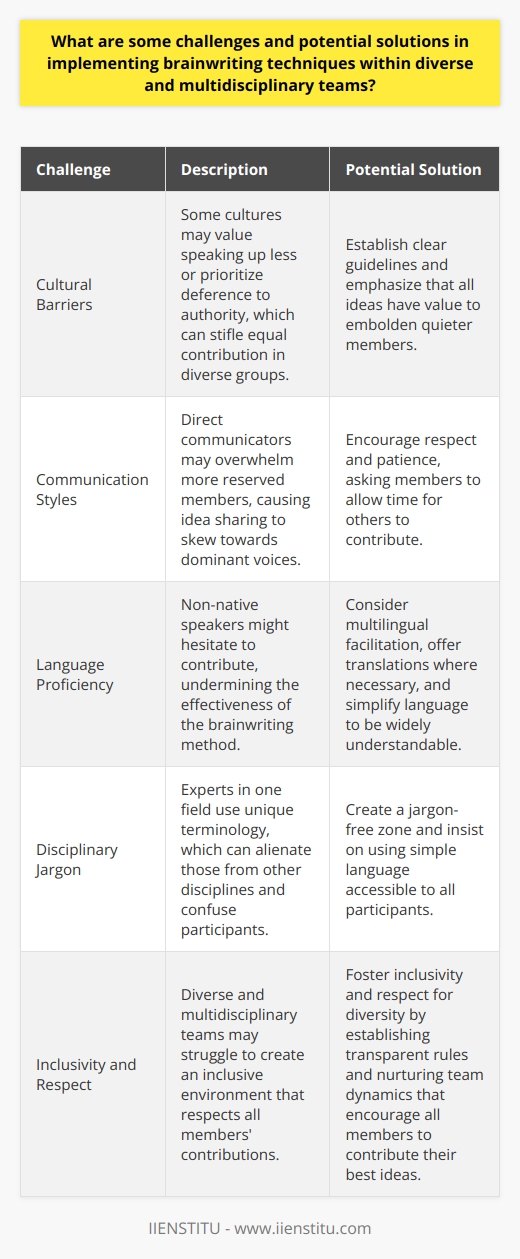
I still remember the day when my team and I were stuck in a conference room, staring blankly at a whiteboard. We were tasked with coming up with innovative ideas for a new product launch, but the usual brainstorming session just wasn't cutting it. Voices overlapped, the usual loud thinkers dominated the conversation, and some of us, including myself, felt our ideas slipping away unspoken. It was then that our manager introduced us to a method called brainwriting, and honestly, it changed the way we approached problem-solving forever.
Unveiling the Power of Brainwriting
From Silent Beginnings to Creative Triumphs
Brainwriting, unlike its more famous cousin brainstorming, revolves around the silent and written exchange of ideas. The concept was developed in the 1960s by German marketing expert Bernd Rohrbach, who introduced the "6-3-5 method". This technique involves 6 people writing down 3 ideas every 5 minutes, resulting in 108 ideas within just half an hour! (Rohrbach, B. (1969). Kreativ nach Regeln — Methode 635, eine neue Technik zum Lösen von Problemen. Absatzwirtschaft, 12(19), 73-75.)
The beauty of brainwriting lies in its simplicity and inclusivity. By allowing team members to jot down their thoughts quietly, it levels the playing field. There’s no need to compete for attention or grapple with the fear of speaking up. Everyone's ideas carry equal weight, penned down anonymously, fostering an environment where creativity can truly flourish.
The Psychology Behind the Silence
From a psychological perspective, brainwriting addresses common social barriers that often stifle creativity. Phenomena like production blocking, where only one person can speak at a time, and evaluation apprehension, the fear of negative judgment, are effectively sidelined. In the silence, everyone has the freedom to think deeply and express ideas without interruption or anxiety. This encourages a more diverse range of thoughts and can lead to truly innovative solutions.
Dr. Paul Paulus, a psychology professor at the University of Texas at Arlington, has done extensive research on group creativity. He found that individuals often generate more and better ideas when they work independently before group discussion (Paulus, P.B. & Yang, H.C. (2000). Idea Generation in Groups: A Basis for Creativity in Organizations. Organizational Behavior and Human Decision Processes, 82(1), 76-87.).
Breathing New Life into Team Creativity
When my team switched to brainwriting, the difference was palpable. The room was filled with the quiet rustling of papers and intense concentration. Later, as we read through the collected ideas, we were amazed at the variety and depth of the suggestions. Even the quietest members had contributed brilliant insights that might never have surfaced during a traditional brainstorming session.
Brainwriting empowered us to:
Value Engineering Guide To Optimize Design And Cost Efficiency
Operational Risk Assessment Guide For Efficient Business Operations
Failure Modes And Effects Analysis Guide For Risk Management
Unlock hidden talents within the team.
Encourage equal participation, regardless of personality type.
Foster a more inclusive and collaborative environment.
The Many Benefits of Brainwriting
Leveling the Playing Field
One of the most significant advantages of brainwriting is that it provides equal opportunities for idea expression. In typical meetings, louder voices can overshadow others, but brainwriting ensures everyone has a chance to contribute without interruption.
Imagine a team where:
1- Introverts feel comfortable sharing their thoughts.
2- Dominant personalities don't monopolize the conversation.
3- Ideas are valued based on merit, not on who presented them.
This was exactly what we experienced. Team members who rarely spoke up started to shine, bringing fresh perspectives that enriched our projects.
Reducing Bias and Encouraging Meritocracy
By anonymizing contributions, brainwriting reduces bias in idea generation. It's human nature to be influenced by who presents an idea, but when all ideas are submitted without identification, they must stand on their own. This cultivates a meritocratic approach where the best ideas rise to the top, regardless of their source.
Enhancing Idea Quantity and Diversity
During our first brainwriting session, we were astonished by the sheer number of ideas generated. Without the constraints of waiting turns or adhering to groupthink, each person could explore their thoughts fully.
Benefits include:
Greater volume of ideas leading to more options.
Diverse perspectives that can combine to form innovative solutions.
Reduced incidence of groupthink, allowing for more creative and unconventional ideas.
According to a study published in the Journal of Creative Behavior, groups using brainwriting generated almost 20% more ideas than those using traditional brainstorming methods (Geschka, H., Schaude, G.R., & Schlicksupp, H. (1973). Modern Techniques for Solving Problems. Journal of Creative Behavior, 7(1), 57-65.).
Mastering the Art of Brainwriting
A Step-by-Step Guide to Successful Sessions
If you're intrigued and want to try brainwriting with your team, here's a simple guide to get you started:
1- Define the Problem Clearly: Begin by stating the issue or goal succinctly to ensure everyone is on the same page.
2- Prepare Materials: Provide paper or index cards and pens. Alternatively, set up a shared digital document if working remotely.
3- Set a Time Limit: Allocate a reasonable amount of time (e.g., 10-15 minutes) for each round of idea generation.
4- Individual Idea Generation: Participants write down their ideas silently.
5- Pass and Build: After the time is up, pass the papers to the next person. They read the previous ideas and add new ones or build upon them.
6- Repeat the Process: Continue passing and adding for several rounds.
7- Collect and Review: Gather all the ideas and discuss them collectively.
Prepping for a Productive Session
Preparation is key. Here's how to ensure your brainwriting session is effective:
Set Clear Objectives: Know what you want to achieve.
Create a Comfortable Environment: Choose a quiet space free from distractions.
Encourage Open-mindedness: Remind participants that all ideas are welcome, no matter how unconventional.
Use Prompts if Necessary: Provide stimuli or questions to spark creativity.
Leading with Confidence: Do's and Don'ts
Do:
Facilitate without dominating: Guide the session but allow ideas to flow organically.
Maintain Anonymity: Ensure that ideas remain unattributed to prevent bias.
Celebrate Creativity: Acknowledge the effort and creativity of the team.
Don't:
Rush the Process: Allow sufficient time for deep thinking.
Criticize Ideas During Collection: Save evaluations for after all ideas are gathered.
Ignore Follow-up: Develop a plan to implement the best ideas.
Real-world Applications of Brainwriting
From Boardrooms to Classrooms
Brainwriting isn't limited to corporate environments. It can be a powerful tool in various settings:
Educational Institutions: Teachers can use brainwriting to encourage student participation.
Community Organizations: Facilitates inclusive discussions in community planning.
Supply Chain Management: Teams can optimize supply chain management process tips by collectively generating innovative strategies.
Optimizing Processes and Fostering Innovation
In industries where process optimization is crucial, such as manufacturing or logistics, brainwriting can uncover hidden inefficiencies and inspire solutions that improve operations. By tapping into the collective knowledge of the team, organizations can stay ahead in competitive markets.
Embracing Brainwriting for Lasting Impact
Reflecting on our journey, integrating brainwriting into our workflow was more than just adopting a new technique—it was a shift in our team's culture. We learned to value each other's contributions more deeply and discovered that sometimes, the quietest voices have the most profound insights.
The Ripple Effects on Team Dynamics
Our communication improved, and trust within the team strengthened. By leveling the playing field, we fostered a sense of belonging and mutual respect. This not only enhanced our creative output but also boosted morale and job satisfaction.
Challenges and How to Overcome Them
Like any new method, we faced initial challenges:
Resistance to Change: Some team members were skeptical. Address this by explaining the benefits and giving it a trial run.
Adjusting to Silence: The quiet can feel uncomfortable at first. Encourage the team to embrace it as a space for deep thinking.
Collecting and Organizing Ideas: With so many ideas, it can be overwhelming. Use categorization and prioritization techniques to manage the information.
Drawing to a Close
Switching from brainstorming to brainwriting was a game-changer for us. It's a simple yet powerful way to unlock the full creative potential of any team. If you've ever felt that traditional meetings aren't capturing all the great ideas your team has to offer, give brainwriting a try.
Remember:
Inclusivity breeds innovation.
Silence can be golden when it comes to idea generation.
Every voice matters, even the quiet ones.
So next time you're faced with a challenging problem or in need of fresh ideas, grab some paper, gather your team, and write your way to success.
References
Rohrbach, B. (1969). Kreativ nach Regeln — Methode 635, eine neue Technik zum Lösen von Problemen. Absatzwirtschaft, 12(19), 73-75.
Paulus, P.B., & Yang, H.C. (2000). Idea Generation in Groups: A Basis for Creativity in Organizations. Organizational Behavior and Human Decision Processes, 82(1), 76-87.
Geschka, H., Schaude, G.R., & Schlicksupp, H. (1973). Modern Techniques for Solving Problems. Journal of Creative Behavior, 7(1), 57-65.
VanGundy, A.B. (1988). Techniques of Structured Problem Solving. Springer-Verlag.
Frequently Asked Questions
What is the underlying psychology behind the effectiveness of brainwriting techniques in stimulating creativity and innovation?
The Psychology of Brainwriting
Encouraging Divergent Thinking
Brainwriting fosters divergent thinking. This process allows participants to generate numerous ideas without interruption. In this silence, individuals explore concepts more freely. They also draw on personal insights and perspectives.
Reducing Social Inhibition
Social dynamics often inhibit idea sharing. Brainwriting reduces such dynamics. Participants work in parallel, minimizing judgment fears. The anonymity in brainwriting further mitigates this issue. It allows more authentic contributions from all.
Stimulating Idea Cross-Pollination
Brainwriting in groups provokes idea cross-pollination. Individuals build on each others' suggestions. This leads to more complex and developed ideas. Continuous exchange sparks further creativity.
Leveraging Group Dynamics
Despite reduced social pressure, group dynamics still play a role. Within a brainwriting session, there exists a collective aim. This fosters a safe space for idea generation. Members support each other, creating a collaborative atmosphere.
Balancing Convergent and Divergent Thinking
Brainwriting balances convergent with divergent thinking. Initial phases involve free idea generation. Later, the process involves refining and converging on viable concepts. This balance is key to effective problem-solving.
Mitigating Dominant Voices
Traditional brainstorming often allows dominant voices to take over. Brainwriting mitigates this. Every participant has an equal platform to contribute. This democratizes the idea-generation process.
Encouraging Comprehensive Participation
Participants might avoid sharing in traditional settings. Brainwriting encourages comprehensive participation. Often, quieter individuals provide the most innovative ideas.
Enhancing Memory Retrieval
The process of writing can aid memory retrieval. Written expression allows individuals to capture fleeting ideas. Over time, recalling these ideas becomes easier. This enhances the overall pool of ideas.
Providing a Tangible Record
Brainwriting leaves a tangible record of the idea generation process. Participants can review and reflect on this record. It serves as a valuable resource for future reference.
Facilitating Synthesis of Complex Ideas
The process is excellent for complex idea synthesis. Participants consider different perspectives and syntheses. They often find interactions between ideas not immediately apparent.
Sustaining Focus and Direction
Brainwriting helps sustain focus. Participants direct their attention to the task at hand. This concentrated effort often yields more fruitful ideas than freeform discussion.
Low Bias Environment
With brainwriting, personal biases diminish. Ideas stand on their own merit. This leads to a more inclusive and varied set of solutions.
In conclusion, the underlying psychology of brainwriting techniques plays a pivotal role in enhancing creativity and innovation. Through fostering an environment that diminishes social biases and inhibition, while promoting divergent thinking and equal participation, brainwriting serves as an essential tool for collaboratively tackling complex problems and generating powerful solutions.

How do different brainwriting techniques compare in terms of their ability to facilitate idea generation and problem-solving in a group setting?
Brainwriting Techniques' Effectiveness in Group Idea Generation
Brainwriting serves as a silent, written brainstorming method. It fosters idea generation without peer pressure. Many variations exist. Each has unique advantages. All aim to improve upon traditional brainstorming.
635 Method
The 635 method requires six participants. Each writes three ideas in five minutes. Ideas circulate among the group. The process stimulates new ideas as participants add or refine others' thoughts. This approach minimizes dominant voices. It allows introverts equal participation. It also generates a diverse idea spectrum. But, it may limit depth in idea exploration.
Brainwriting Pool
In the brainwriting pool technique, participants write ideas on cards. They place these into a central pool. Others can draw cards. They then add or modify the ideas. This technique encourages non-linear thinking. It prevents idea ownership. Thus, it promotes a more collaborative atmosphere. Still, it may lead to repetition. It could also overwhelm some participants. Complex ideas might overwhelm those less familiar. Organizing the output afterwards is challenging.
Idea Card Method
Idea cards offer another variant. Participants jot down ideas on cards. Mention problem aspects and possible solutions. They trade these cards among themselves. This method encourages detailed, actionable ideas. It balances quantity and quality. However, card management can be cumbersome. It can disrupt thought flow. Some ideas end up lost or overlooked.
Slip Writing
Slip writing involves writing ideas on slips of paper. Then give those to a moderator. This method provides anonymity. It can prevent bias. It ensures each idea is reviewed. Yet, the moderator may unwittingly influence idea selection. Some ideas might not get the necessary elaboration. The pace depends on the moderator’s efficiency.
Analysis of Effectiveness
Each technique enhances idea generation differently. They cater to diverse group dynamics. They solve problems in varied contexts.
635 and slip writing are better for quick, broad idea generation. They encourage quantity over depth. They work well for less complex issues. They need less participant preparation.
Brainwriting pool and idea cards foster more elaborated ideas. They support complex problem-solving. They require more participant engagement. They may take longer. They could result in more actionable, detailed outcomes.
In conclusion, choice of technique depends on group composition. It also depends on the problem's complexity. Optimal idea generation requires aligning the method with the group's needs. Experimenting with different techniques can reveal what suits a particular team best. Each brainwriting method has its place. Adaptation and flexibility enhance idea generation and problem-solving in any group setting.

What are some challenges and potential solutions in implementing brainwriting techniques within diverse and multidisciplinary teams?
Understanding Brainwriting in Teams
Brainwriting remains an intriguing tool for idea generation. It fosters anonymous idea sharing, thus promoting equality. But within diverse groups, challenges often arise. Members' varied backgrounds can influence participation.
Challenges in Diverse Teams
Cultural Barriers prove significant. Some cultures value speaking up less. Others may prioritize deference to authority. This diversity can stifle equal contribution. Diverse groups sometimes struggle with Communication Styles. Direct communicators may overwhelm more reserved members. Consequently, idea sharing might skew towards dominant voices. Language Proficiency often varies.
Non-native speakers might hesitate to contribute. This hesitancy can undermine the method's effectiveness. Disciplinary Jargon confuses participants. Experts in one field use unique terminology. This specific language can alienate those from other disciplines.
Potential Solutions for Effective Brainwriting
To address Cultural Barriers, establish clear guidelines. Emphasize that all ideas have value. This assurance can embolden quieter members. For Communication Styles, encourage respect and patience. Ask members to allow time for others to contribute. To ensure Language Proficiency, consider multilingual facilitation. Offer translations where necessary. Simplify language to be widely understandable. To combat Disciplinary Jargon, create a jargon-free zone. Insist on using simple language accessible to all.
Brainwriting in diverse, multidisciplinary teams can face hurdles. Yet, with strategic approaches, it can flourish. The right solutions foster inclusivity and respect for diversity. Also, establishing transparent rules aids the process. These team dynamics nurture a fruitful brainwriting environment. Thus, all members contribute their best ideas.



